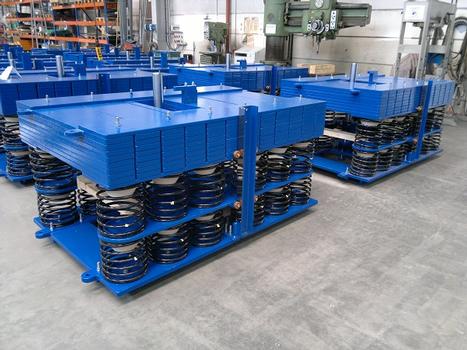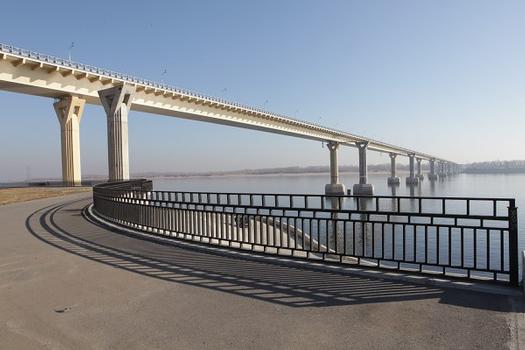Dancing Bridge of Volgograd tamed
The video which displayed the "dancing bridge of Volgograd" got world wide attention. In particular laymen made venturesome speculations of waves several meters high – in reality the vertical vibrations of the bridge deck were in the range of ± 400 mm. But already these vibrations were enough to temporarily close the bridge for traffic, and to conduct comprehensive analyses about the cause of the problem. It was Maurer Söhne in Munich that spoiled the sport of the world community of mockery. In collaboration with the Swiss Institute Empa and mutually with the "Universität der Bundeswehr" (University of the German armed fores) in Neubiberg, Germany, a concept was developed and implemented to dampen the steel bridge retroactively with 12 adaptive tuned mass dampers, with a mass of 5,200 kg each.
Maurer Söhne dampens Europe's longest road bridge
In October 2009, Volgograd (earlier: Stalingrad) got its urgently needed bridge over the river Volga. With a length of 7.1 km, it is the longest road bridge in Europe. After a construction time of 12 years, it was completed, but already half a year later it had to be closed for traffic again, reason being the massive vibrations it displayed. After a complete closure, the bridge was gradually opened again for traffic: first for the light vehicle traffic, followed by truck traffic. Cause of the vibrations is a constant side wind (and not a storm), which at a certain wind speed triggers the vibrations, because then the vortices in the wind shadow break away. These vibrations match exactly the natural frequency of the bridge, and so the bridge starts to vibrate, with an amplitude of ± 400 mm.
The Volga bridge is designed in a very slender way and is completely made of steel. In other words, it is a giant coil spring, which displays optimum preconditions for vibrations, with long periods of post-pulse oscillations.
Between feasibility and necessity
The bridge had to be dampened, but the soft and slender design of the bridge displayed another problem: how much damper mass will the bridge be able to bear, when its fields of a length of up to 155 m already incur considerable vertical deflections when trucks pass the bridge? In other words, the normal traffic already caused a constant unrest in the bridge. Peter Huber, project manager at Maurer Söhne, explains: "The challenge was to find a compromise between a damper mass which is structurally feasible, and a damper mass which is necessary to calm down the bridge and to react to this special load case." Last but not least, the retrofit should be financially bearable.
As a result of the pilot survey driven by Univ. Prof. Dr.-Ing. Ingbert Mangerig of the "Universität der Bundeswehr" in Neubiberg, Germany, a damper mass of 12 adaptive units of 5,200 kg each was installed. However, the total mass was not spread equally over the length of the bridge, but was concentrated on those fields where the bridge displayed the strongest vibrations. Each of the 3 fields received 4 adaptive dampers, which had to cater to three requirements:
- To calm down the bridge generally in case of normal traffic.
- Reduce the period of post-pulse oscillation.
- Reduce the maximum vertical amplitude in the centre of the field from ± 400 mm to ± 40 to 95 mm. A further reduction for example to zero was not possible because the mass of the damper is too small in relation to the mass of the bridge.
Although the tuned mass dampers were installed only in three fields, the effects could be applied to the entire bridge, because it consists of one vibrating unit.
Adaptation in real time
The mass dampers are tuned to the natural frequency of the bridge. However, because the bridge vibrates between 0.41 and 0.68 Hz and in addition depends on other factors like temperature and material fatigue, dampers were installed which can adapt themselves within a certain range.
These adaptive dampers are patented by Maurer Söhne and were installed already at several bridges for the damping of stay cables, like at the Kampen Bridge (Netherlands), Dubrovnik (Croatia), and Sutong Bridge (China). This application for damping a bridge deck however is the first time worldwide. By way of employing adaptive dampers, the number of the mass dampers could be reduced from 36 (theoretical) to 12.
In the mass damper, the damping parameters are regulated autonomously in the hydraulic damping element by way of an electronic system. A sensor measures the natural frequency, sends the data to a computer which calculates the desired response force of the damper and sends its result back to the damper by way of electrical impulses. In the hydraulic damping elements, a magneto-rheologic fluid is controlled by a magnetic field which controls the shear strength of the fluid. The electrical impulses are sent to a coil and thus control by way of modification of the magnetic field the response force, with which the damper reacts. This control occurs in real time with a reaction time of between 50 and 100 msec. In addition, a monitoring system stores the movement data of the mass dampers.
Installation in 100-kg-servings
The installation of the mass dampers which was conducted in August and September 2011 posed a challenge. The bridge girder consists of a continuous steel box, which is accessible for the sake of maintenance only at the abutments. It was therefore not practicable to carry the damper elements from these accesses over several kilometres through a bridge deck which is stabilised by strut members. Consequently, the bridge deck was opened directly at the locations of installation from the outside, by way of flame cutting, to a size of 2,000 x 80 mm. The damping elements were disassembled in units of maximum 100 kg. An elevating platform truck with cantilever arms lifted the parts in front of the created hole, and over a slide they were shifted into the interior, where they were reassembled – made of around 100 individual parts. After completion of the assembly, the holes were closed again by welding, to make sure that the structural system of the bridge is not weakened. The maintenance will be accomplished via the entrances at the abutments.
Since the mass dampers were installed, the special load case "constant side wind" so far did not yet occur. Only then it will turn out how the bridge behaves at the hand of amplitudes of a maximum of 80 to 95 mm, and whether the bridge must again be closed temporarily for traffic. In any case however, the vibrations will no longer pose a danger for the bridge structure.
References
Structure Types
- About this
data sheet - Product-ID
5993 - Published on:
14/08/2012 - Last updated on:
19/05/2017



 MAURER SE
MAURER SE 

